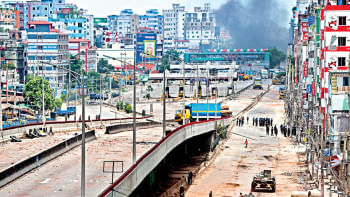A year of living with the pandemic

With the novel coronavirus spreading to different countries across the globe early last year, there was then an obvious fear that the pandemic would hit Bangladesh's shores soon.
People were glued to the television to get updates of the Covid-19 situation from daily briefings by the government.
And then, on a spring afternoon on March 8, 2020, the grim yet inevitable apprehension came true -- Bangladesh confirmed the first three cases of Covid-19.
Our lives changed quickly and dramatically after that announcement as it brought in relentless waves of stress and grief. The customary rituals we had taken for granted -- like shaking hands, exchanging hugs, partaking in social and religious gatherings -- were no longer considered safe.
Instead, we started wearing masks, using hand sanitisers and soon, they just became something we took with us as we exited the house.
The next set of infections spread rapidly, prompting the government to impose shutdown a week after the detection of the first cases. With that, we embarked on the work-from-home era. Places were shut down and we hunkered down at home -- bedrooms became workspaces, kitchens became canteens.
Workplaces and classrooms went remote. Large events were cancelled or postponed. Businesses were shuttered and jobs and livelihoods lost.
Over the next few months, the infection numbers grew sharply and steadily. At one point, we were detecting 18,000 cases every day. Since the pandemic hit, we've racked up more than 8,400 deaths. More than 5,50,330 people have been infected.
Despite getting time, the government initially failed to take adequate preparations. As a result, there was initially a crisis of equipment and manpower at the healthcare facilitates. There was a lack of adequate testing and treatment facilities. The crisis of ICU facilities added to people's woes.
However, over time, the government ramped up its efforts, increasing the testing facilities to stem the spread of the deadly virus. It also took steps to expand ventilation facilities. The efforts helped yield some positive results and eventually contributed to a decline in the number of cases.
The number of new cases continued to decline for over the last three months with the downward progression remaining unaffected by the easing of movement restrictions, social gatherings and festivals.
The average number of daily new detections has fallen to around 600. Fewer than 10 deaths are being reported every day from across the country. It comes at a time when the pandemic continues to rage in several American and European countries.
Then, after a tough year the New Year brought renewed hope as scientists made a tremendous effort to prepare a vaccine against Covid-19 in the shortest period of time. The government too managed to secure a substantial amount of Covid-19 vaccines. On February7, the nation launched the vaccination drive. In the first phase of the drive, 1.5 crore people will be vaccinated on a priority basis.
With a year of the pandemic era having gone by, things have come back to something resembling pre-pandemic times. The economy is recovering gradually with some people starting to look to the future. There are other still trying to hold on.
However, the pertinent question that is being asked now is how much longer the nightmare will last.
The answer, obviously, is that we don't know. But equipped with a nationwide vaccination drive, there is some hope.
Bangladesh still has a long way to go.

 For all latest news, follow The Daily Star's Google News channel.
For all latest news, follow The Daily Star's Google News channel. 



Comments